Ravaged by war, Russia's army is rebuilding with surprising speed
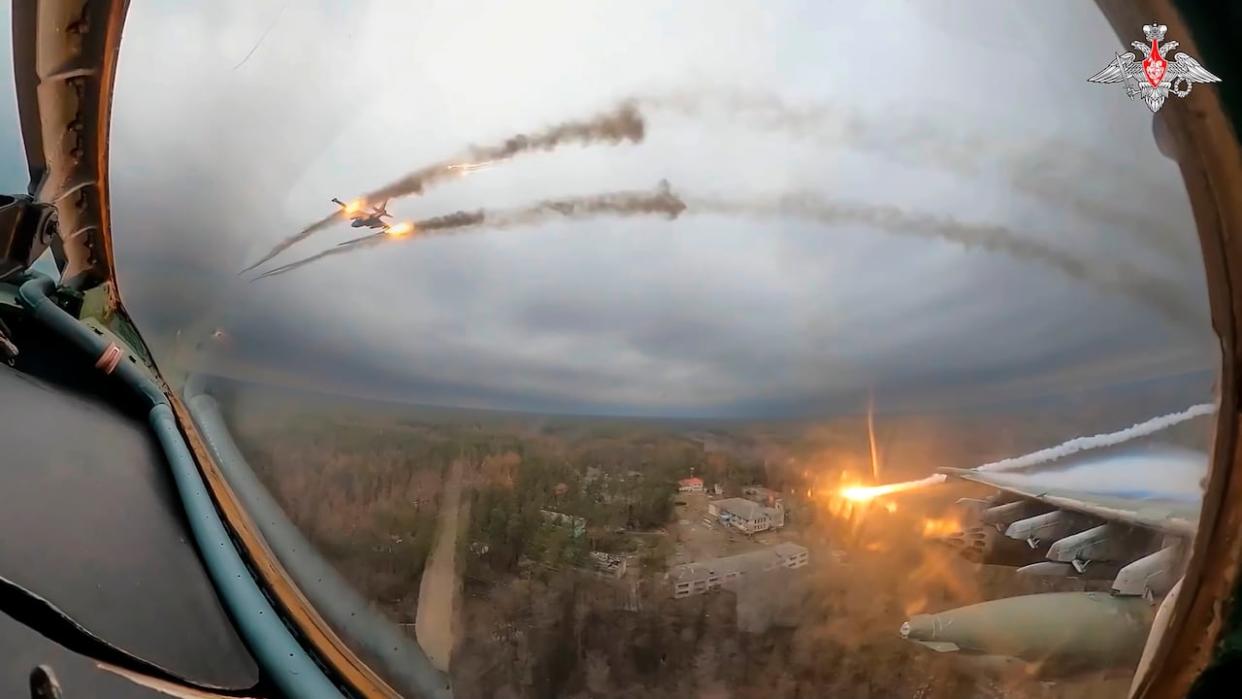
As the second anniversary of the full-scale invasion of Ukraine arrives, the Russian Army is showing a remarkable capacity to take extraordinary punishment and regenerate itself at a pace western military leaders and experts had not anticipated.
Only nine months ago, American intelligence officials were telling the U.S. Senate Armed Services Committee that it would take a decade — or more — for Moscow to recover from the staggering losses inflicted by Ukrainian defenders. The German Council on Foreign Relations refined that estimate last fall, warning that the window would be more like five to eight years.
"They are sparing no effort in their reconstitution," Gen. Christopher Cavoli, NATO's supreme allied commander, said last month after a meeting of the alliance's chiefs of defence staff.
"They are devoting an enormous fraction of their budget to the military over the coming years, next year specifically, and they are running their defence industrial base just as fast as they can right now."
Other top military commanders also acknowledge the shift but qualify their assessment by saying that while Moscow is churning out quantity, it may not be achieving quality.
"The number of [Russian] forces that have been going into Ukraine has increased over the last two and a half years, but qualitatively it is going down in terms of the land domain — and that is both in their capabilities and in the personnel capabilities," said Dutch Admiral Rob Bauer, the chair of NATO's military council.
"It has more people, but it's less trained than when they started the war in the land domain. They lost a lot of tanks, a lot of armoured vehicles, they've lost airplanes, they lost helicopters ... a lot of equipment."
Last week, a senior U.S. Pentagon official estimated that as many as 315,000 Russian soldiers have died or been wounded since the full invasion on Feb. 24, 2022 — essentially the entire army with which Russia started the war.
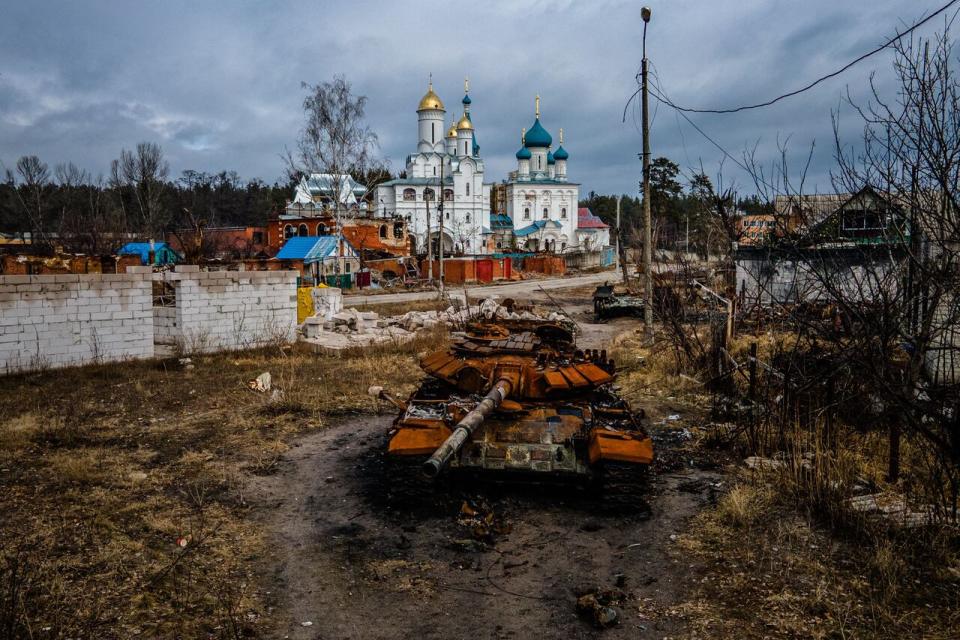
A destroyed Russian T-72 tank near Pokrovy Presvyatoyi Bohorodytsi Church in the city of Svyatohirs'k, Donetsk region, on March 1, 2023. (Ihor Tkachov/AFP/Getty Images)
The Kremlin has had to dig deep into its inventory to carry out its renewal.
"They're rebuilding, but most of the time it's older types [of armoured vehicles] they're rebuilding, or they're taking types out of capabilities or equipment out of stock, which is most of the time also older equipment," Bauer said.
That's likely cold comfort to the Ukrainians who were forced to withdraw from the strategic eastern town of Avdiivka last weekend after months of holding off Russian human wave attacks — attacks which, according to international media reports, have left the surrounding streets and fields littered with corpses.
The Kremlin's strategy is clear: use the country's enormous manpower advantage and deep well of Cold War military hardware to grind down the Ukrainians.
The quality of quantity
"They are most obviously going to reconstitute but it is hampered by the sanctions," Bauer said. "It is hampered by money issues and it is just hampered by their ability to produce enough, especially the more modern equipment.
"But they're doing actually rather well in terms of their artillery production and their older tanks. So I think that is, of course, a concern, because in the end, sometimes quantity becomes a quality in itself."
The London-based Royal United Services Institute (RUSI) last week produced a study that provides the most comprehensive snapshot of where the Russian military has come from and where it's likely headed in the coming years.
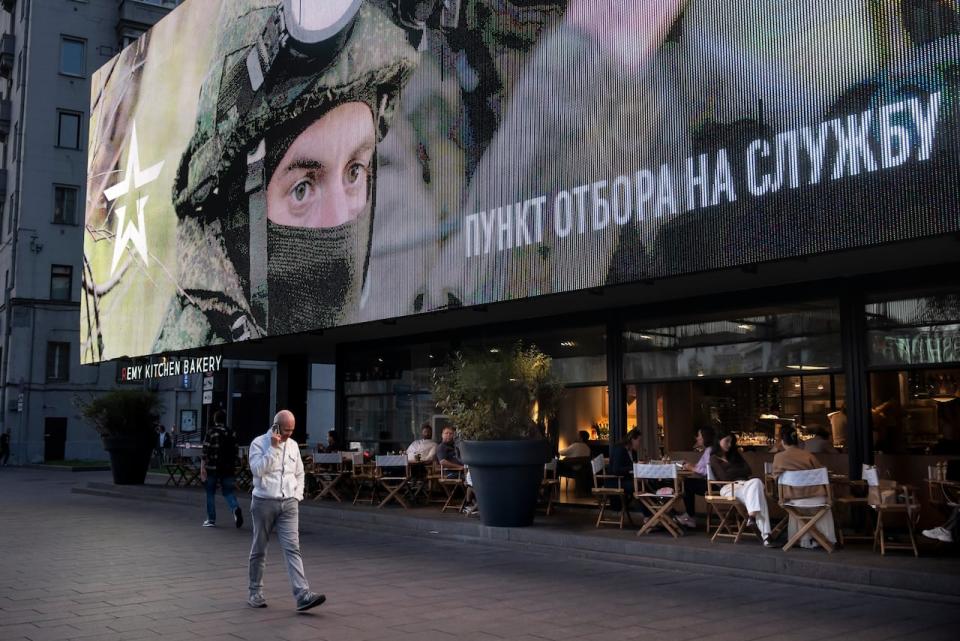
A man walks past a Russian armed forces recruitment ad in the centre of Moscow, Russia on Thursday, Sept. 28, 2023. (Alexander Zemlianichenko/Associated Press)
"The Russian military began 2023 with a highly disorganized force in Ukraine comprising approximately 360,000 troops," military experts Jack Watling and Nick Reynolds wrote in the study, released on Feb. 13.
"By the beginning of the Ukrainian offensive in June 2023, this had risen to 410,000 troops and was becoming more organized. Over the summer of 2023, Russia established training regiments along the border and in the occupied territories and — following the mutiny of Wagner forces — endeavoured to standardize its units, breaking down the previous trend toward private armies.
"By the beginning of 2024, the Russian Operational Group of Forces in the occupied territories comprised 470,000 troops."
Smaller attacks, steady losses
The RUSI report said that with no large-scale offensives underway, Russian units are conducting smaller tactical attacks that "at minimum inflict steady losses on Ukraine and allow Russian forces to seize and hold positions."
Russia's ministry of defence has said it wants to expand the military to 1.5 million personnel, a plan that has not been realized. RUSI's report says "recruiters are currently achieving almost 85 per cent of their assigned targets for contracting troops to fight in Ukraine. The Kremlin therefore believes that it can sustain the current rate of attrition through 2025."
In a separate analysis released recently, Franz-Stefan Gady of the International Institute for Strategic Studies said that Russia has several material advantages, notably in artillery.
"Russia will also continue regenerating combat power, recruiting more than 10,000 troops per month," Gady said.
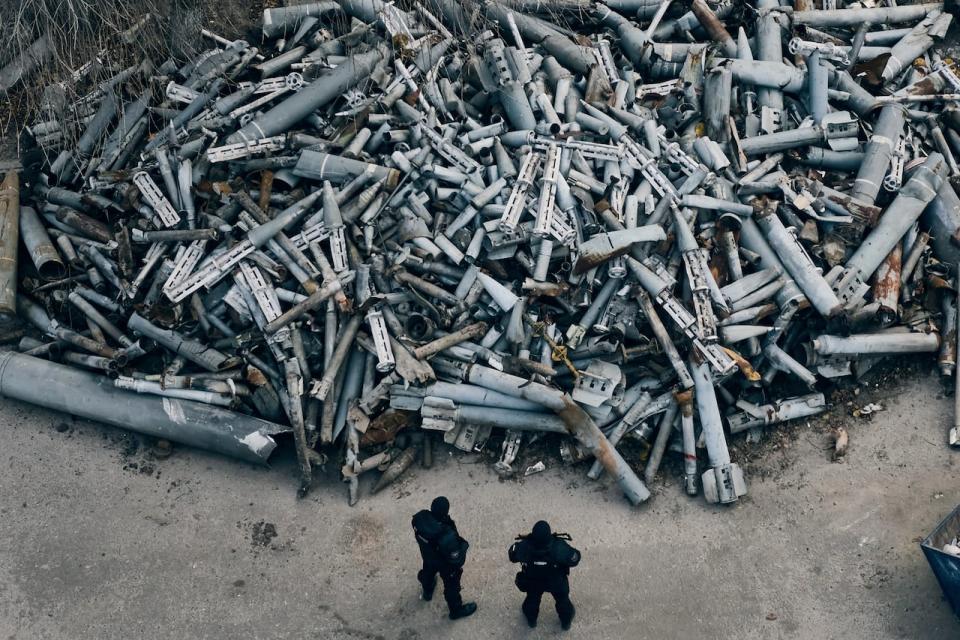
Police officers look at collected fragments of the Russian rockets, including cluster rounds, that hit Kharkiv in Kharkiv, Ukraine on Saturday, Dec. 3, 2022. Russian President Vladimir Putin said in an interview published Sunday that Russia had a “sufficient stockpile” of cluster munitions, warning that Russia “reserves the right to take reciprocal action” if Ukraine uses the controversial weapons. (AP)
Moscow recently announced it intends to spend six per cent of its gross domestic product on defence, a significant increase over 2023.
"Its apparent intent is to overwhelm Ukraine through defence-industrial mobilization and sustained regeneration of combat forces," Gady said.
But other experts note that Russia is getting significant outside help from its allies.
"As I look at Russian efforts over the past several months, there is a significant effort to reinvigorate the defence industrial base for a protracted war," said Seth Jones of the Washington-based Center for Strategic and International Studies (CSIS).
"I think it's reasonable now to expect that Russians now have stockpiles that they would be able to fight for at least another year or two."
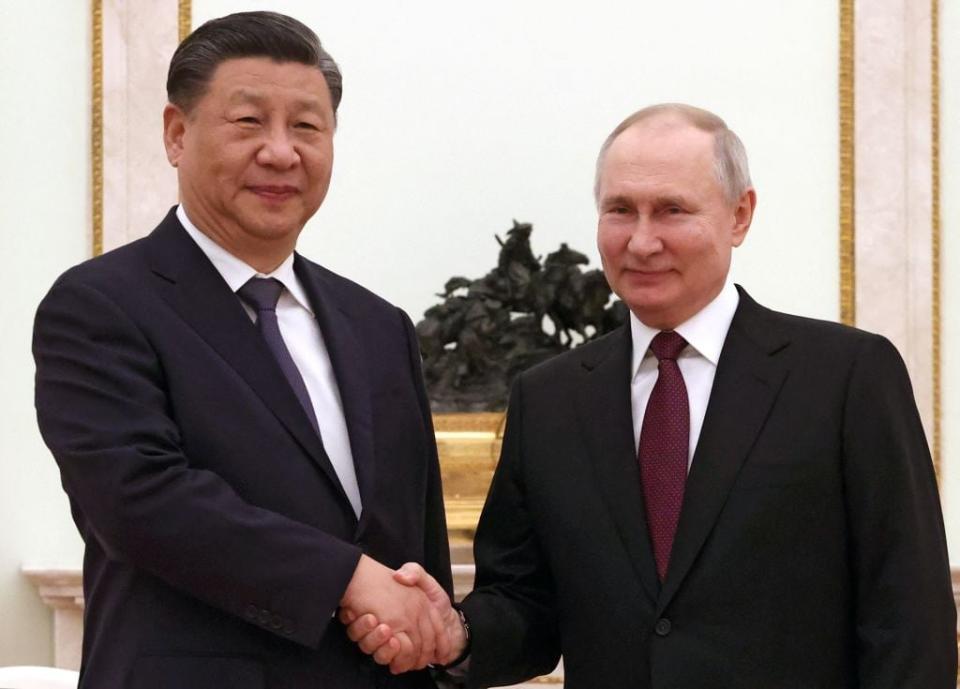
Russian President Vladimir Putin meets with China's President Xi Jinping at the Kremlin in Moscow on March 20, 2023. (Sergei Karpukhin/Sputnik/AFP/Getty Images)
Jones also pointed to declassified U.S. intelligence assessments that indicate China has ramped up military aid to both the Russian military and its intelligence services. China has supplied components for navigation equipment in M-17 military helicopters, jamming technology for military vehicles, parts for fighter jets and components for defence systems like the S-400 Surface-to-Air Missile System.
Iran has supported Moscow with Shahed 136s and the Mojaher 6 drones and plans to build a drone factory near the Russian town of Yelabuga. North Korea has provided artillery shells and munitions for Moscow's war in Ukraine.
"So I certainly think along those lines the Russians have the ability to continue to fight for quite some time," said Jones.
U.S. Under Secretary of State for Political Affairs Victoria Nuland said that wider support for the Kremlin's war is alarming.
"Everybody else is investing — including the United States — in our future, and [Russian President Vladimir] Putin is investing in death and destruction," Nuland said Thursday during an online forum hosted by CSIS.
"We should all be horrified that he is now getting drones made for him, not only in Iran but by Iranians in Russia, that he's cut some deal with [Kim Jong Un] in [North Korea]. And who knows what kind of technology Russia is trading to get 155 [millimetre artillery] ammunition that it's using on the battlefield. So this is massively destabilizing."
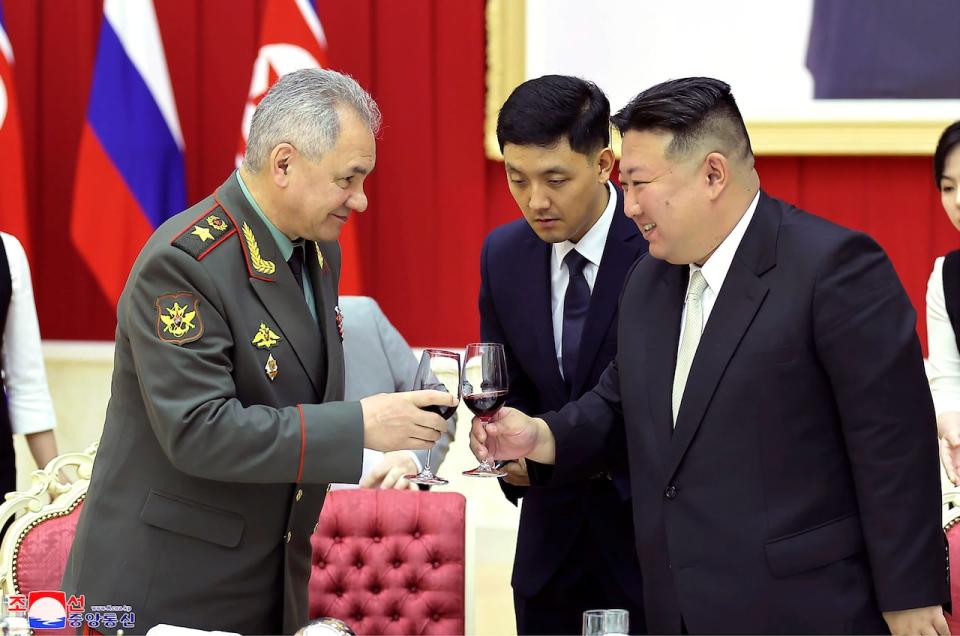
In this photo provided by the North Korean government, North Korean leader Kim Jong Un, right, and Russian Defence Minister Sergei Shoigu, left, toast at a banquet hall of the ruling Workers' Party's headquarters in Pyongyang, North Korea on Thursday, July 27, 2023. Shoigu visited Pyongyang in what the U.S. saw as part of Moscow's efforts to negotiate for supplies of North Korean munitions. (Korean Central News Agency/Korea News Service via AP)
Maria Snegovaya, a postdoctoral fellow at Washington's Georgetown University and a resident expert at CSIS, said there are a few signs of war fatigue in Russia, with a recent poll showing 50 per cent in favour of a negotiated peace.
At the same time, Boris Nadezhdin, a politician who wanted to run against Putin, has campaigned for an end to the war. He collected more than 20,000 signatures to run in the upcoming presidential election, but he wasn't allowed into the race.
Multiple experts say Ukraine's best strategy, for the time being, is to dig in and create the kind of defensive positions that the Russians have created on their side of the line — the fortifications and anti-tank ditches that helped blunt Ukraine's counteroffensive in the east and south last summer.
At the moment, RUSI estimates Russia has approximately 4,780 artillery pieces, 1,130 rocket-launcher artillery systems, 2,060 tanks of various designs and 7,080 other armoured fighting vehicles. It is also supported by 290 helicopters, of which 110 are attack helicopters, and 310 fixed-wing fighter-bombers.
It's an army that will only continue growing, the British think-tank said.
"Russia is delivering approximately 1,500 tanks to its forces per year, along with approximately 3,000 armoured fighting vehicles of various types," the RUSI report said.
"Russian missile production has similarly increased."


